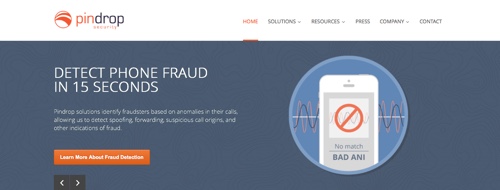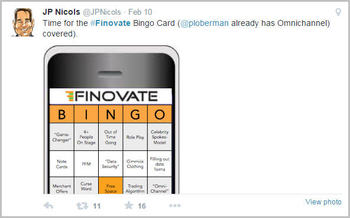
FinovateEurope 2015 concluded last week and was a huge success. Not only did we host a record-breaking audience, we also saw the most press coverage.
Thanks to all of the contributors who worked hard to document the great technology demonstrated on stage. A special thanks to the analysts at Datamonitor for their extensive coverage.
Here’s the coverage in alphabetical order:
American Banker
U.K. Banks Pilot Loan Sales to Crowdfund Site investUP
Bailey Reutzel
Link
Bank Innovation
Xignite APIs Now Powering +50 FinTech Ventures
by Philip Ryan
Link
Banking Technology
Delegates skeptical at Finovate London
by Elliott Holley
Link
Bob’s Guide
Show report: The best innovators at FinovateEurope 2015
by Nicole Miskelly
Link
CC Group
Finovate Europe 2015—a microcosm of FinTech?
by Daniel Lowther
Link
C’est Pas Mon Ideé blog
Redy, paiement mobile et monnaie virtuelle
by Patrice Bernard
Link
Link (Translated to English)
City A.M.
Finovate Europe: Global FinTech stars meet up at London’s Old Billingsgate
by Oliver Smith
Link
Cloud Lending blog
Cloud Lending at Finovate Europe 2015
by Vidur Jain
Link
CNBC
The valuation industry is now big business
by Jenny Cosgrave
Link
Cognito
Finovate: Understanding what the media wants
by Paul Bowhay
Link
ComputerWorld
Telenor banka și Asseco SEE prezente la prestigioasa Conferință Finovate de la Londra
by Adaugat de Dali Dinu
Link
Crowdfund Insider
investUP launches New Platform at Finovate Europe
by Samantha Hurst
Link
Datamonitor
Finovate FinTrack: Advice Games
by Sean Harrison
Link
Finovate FinTrack: BankClip by Crealogix
by Helen Allingham
Link
Finovate FinTrack: Fiserv
by Theresa Jameson
Link
Finovate FinTrack: mydesq
by Katri Tuomainen
Link
Finovate FinTrack: PROFOS by CPB Software
by Helen Allingham
Link
Finovate FinTrack: Quisk
by Samuel Murrant
Link
Finovate FinTrack: Yoyo
by Theresa Jameson
Link
Finovate FinTrack: Novabase wizzio
by Daoud Fakhri
Link
Finovate: Our Best in Show
Link
FinTrack FinovateEurope 2015 Special: Day One (Report)
Link
FinTrack FinovateEurope 2015 Special: Day Two (Report)
Link
Finance Zweinull
Die Letzte Finovate
by Boris Janek
Link
The Financial Brand
Radical Bank Branch Design Fuses Digital with Physical
by Jim Marous
Link
Finextra
Finovate Europe 2015—Day 1 roundup
Link
Finovate Europe 2015—Day 2 Roundup
Link
Finews.ch
Fintech: Fünf heisse für Trends 2015
Link
Finovate
FinovateEurope 2015 Best of Show Winners Announced
by David Penn
Link
Forrester’s Benjamin Ensor’s Blog
Finovate Europe 2015: Execution Is Harder Than Idea Generation
by Benjamin Ensor
Link
FS Tech
Finovate reveals ‘best of show’ winners
by Michelle Stevens
Link
Innovation in Finance
Coinjar interview at Finovate Europe, London, February 2015
by Damien Ducourty
Link
Lets Talk Payments
The Best of FinTech Europe from Finovate 2015
by Kate
Link
LinkedIn Pulse
Fintech isn’t just for ‘Fins’
by Matthew Stammers
Link
Time for a Finovate Fringe Festival?
by David Jones
Link
Mapa Research
Finovate Europe 2015: Our top picks from day one
by Katie Nachshon
Link
Mollie
Mollie: een pionier in de Fintech
by Remco Boer
Link
My Private Banking
Wealth Management Solutions at FinovateEurope 2015
by Francis Groves
Link
Nostrum Group
Finovate Day 1—reflections from FinTech’s showpiece
Link
Finovate Day 2—FinTech’s focus is on user experience
Link
FinovateEurope 2015—Nostrum’s reflections
Link
Ormsby Street
Key Performance Metrics
by Martin Campbell
Link
Payment Eye
3 ways payment technology is boosting financial inclusion
by Lindsey Kennedy
Link
Payments Journal
Recapping Finovate London 2015
by Tristan Hugo-Webb
Link
Pirean blog
Pirean demonstrate their Identity and Access Management as a service offering at FinovateEurope 2015
Link
Sitepoint.com
Finovate 2015, the Part Mobile is Playing in Fintech
by Chris Ward
Link
Rts.rs
Banka u džepu – tehnologija budućnosti
Link
SME Finance Forum
Finovate Europe 2015—bigger and even more interesting than last year!
Link
SME Insider
3 of the best new technologies to supercharge SME growth
by Lindsey Kennedy
Link
How to get the funding you need to grow your business
by Lindsey Kennedy
Link
Tech City News
Fintech monthly: Judopay raised $6 million, banking apps tested, Finovate Europe and much more…
by Ben Goldsmith
Link
Tech Cocktail
LifePay Acquires iboxPro, Expands into Asian Markets
by Will Schmidt
Link
The Telegraph
Banks get out their chequebooks to chase the next banking revolution
by Marion Dakers
Link
Le Temps
Du gadget à l’innovant, tour d’horizon des nouveautés de la finance
by Mathilde Farine
Link
Treasury Insider
The 5 hottest new trends in fintech
by Lindsey Kennedy
Link
Waters Technology
KPAX Brings Data Reconciliation Product to the Cloud
Link
World Finance
Heilmann: ‘Germany needs to take a hardline on Greek debt’
Link
As more coverage is published, we’ll be adding it to this post in the coming weeks. If you have a piece you’d like us to include, please contact [email protected].
 American Banker: Retail Banking Vet Deanna Oppenheimer Joins Tech Vendor Finsphere.
American Banker: Retail Banking Vet Deanna Oppenheimer Joins Tech Vendor Finsphere.





 FinovateEurope 2015:
FinovateEurope 2015: 


























